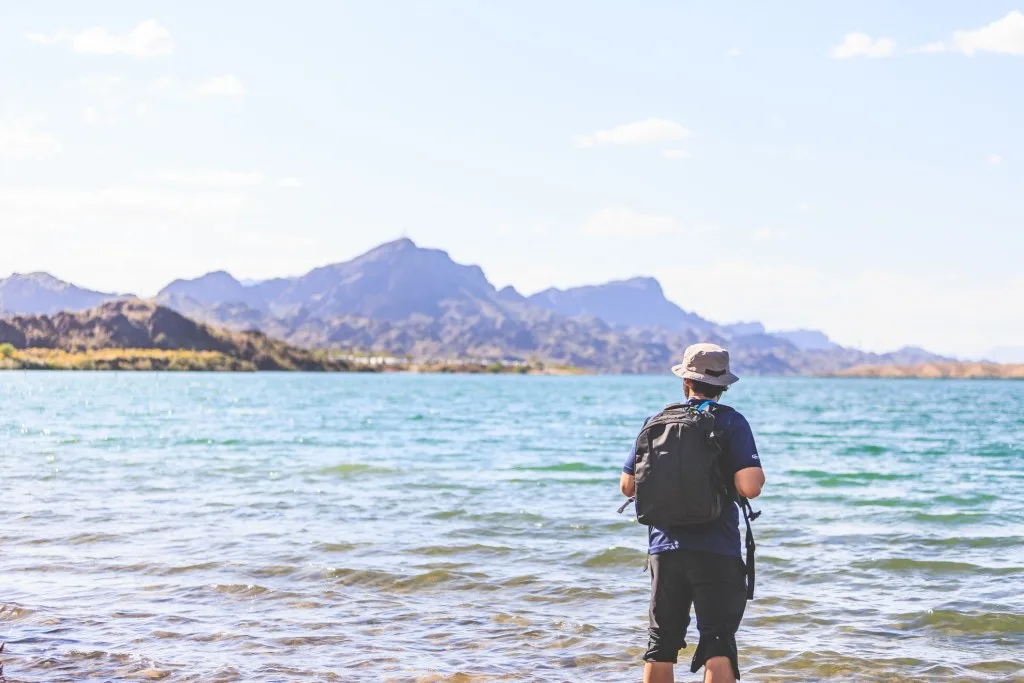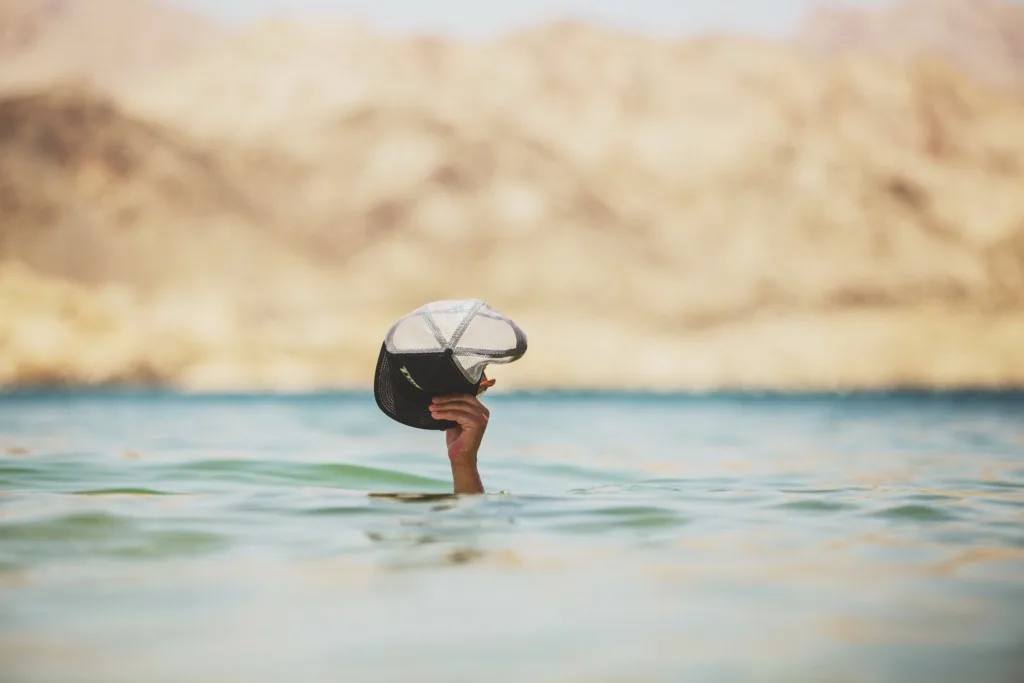Lake Mead Recreation Area is 1.5 million acres of mountains, canyons, valleys, and two massive lakes. This recreational area has year-round swimming, boating, hiking, cycling, camping, and fishing. It’s an outdoor playground beckoning adventurers to play.
However, with so many exciting activities, it’s easy to overlook the dangerous creatures that call Lake Mead home.
Let’s look at a few creatures we suggest you look out for during your adventures here.
What Makes a Creature Dangerous?
A creature is dangerous when it poses a risk to humans and their pets. Many animals pose minimal risk to humans due to our size. However, these same animals can be very dangerous to our pets. And since many of us enjoy hitting the trails and other adventures with our dogs, we label the creatures as dangerous.
Many animals will see us, recognize that we’re bigger, or hear us and run off into the wilderness. However, dogs typically make less noise and are less intimidating. So to keep you and your pets safe, make sure you keep pets close to you while you’re on an adventure.
Where Is Lake Mead?
Lake Mead sits on the Nevada/Arizona border. The recreational area is approximately 30 miles east of Las Vegas. It is a massive reservoir on the Colorado River and formed due to the creation of the Hoover Dam. The park is one of the top destinations in the entire state of Nevada.
So, make sure you build some time into your schedule to check it out if you’re passing through the area!
Pro Tip: After camping in Lake Mead, check out these stunning 13 RV Boondocking Spots You Must See to Believe!

The Most Dangerous Animals in Lake Mead
It can be easy to get distracted by the brightly colored rocks and the bright blue waters. However, be alert as a few dangerous animals hide around the park!
Mountain Lions
You may have heard them referred to as cougars, pumas, panthers, yellow cat, catamount, or a host of other names. However, they’re all mountain lions, and while sightings are rare, they do exist within Lake Mead Recreational Area. There’s no exact count for how many call the park home, but there are believed to be over 2,000 mountain lions throughout Nevada.
You’re very unlikely to see a mountain lion. So much so that the International Union for Conservation of Nature assigns them the rating of “least concern.” They’ll typically avoid human interaction, but the National Park Service (NPS) states that attacks have become more frequent over the past few decades. Remember that you’re more likely to be struck by lightning than attacked by a mountain lion. This is largely because humans are building houses in more rural areas where mountain lions reside.
Bobcats
Bobcats are another dangerous creature that calls southern Nevada home. Much like mountain lions, bobcats typically avoid human interaction. However, if they’re hungry and spot a small animal roaming the area, they’re going after it. They won’t care if it’s your pet or not; they’re looking for a meal.
Make sure you keep your pets close to you while hiking and always maintain a clean campsite. You don’t want to attract birds or chipmunks to your campsite, as this can innocently attract bobcats. If you encounter a bobcat, back away slowly and make lots of noise. It can be tempting to run, but this will likely trigger the hunting instinct in the bobcat.

The Most Dangerous Reptiles and Amphibians in Lake Mead
Cats aren’t the only dangerous animals in Lake Mead. There are also a handful of reptiles and amphibians that you should watch for while adventuring here.
Rattlesnakes
Rattlesnakes are one of the most feared reptiles in Lake Mead and the entire southwest region of the country. The distinct rattling sound is enough to send chills down any hiker’s spine and stop them in their steps. Rattlers are typically most active between April and October when the weather is between 70 to 90 degrees.
The best way to avoid rattlesnakes is to use hiking poles and stay on trails. If you’re making noise and walking heavy-footed, they’ll sense you and hurry out of the way before you even see them. However, you can reduce your chances of getting bitten by never putting your hands or feet anywhere you haven’t already looked. Don’t forget to keep your pets close, as they’re likely to be a bit curious.
If you encounter a rattler, give it plenty of space and let it take its time crossing. The last thing you want to do is cause the snake to feel threatened. Doing so will likely result in getting bitten, which can send you to the hospital in a hurry.
Gila Monsters
If you didn’t know, the Gila Monster is one of two venomous lizards worldwide and calls Lead Mead home. However, Gila Monsters are non-aggressive lizards and will rarely bite a person. Despite that, it has dangerously toxic venom.
A bite from a Gila Monster is a grave issue that you should not ignore. If a Gila Monster bites you, you’ll begin to experience respiratory system issues and eventually paralysis. The lizard doesn’t use fangs like a rattlesnake but will slowly chew through its prey’s flesh as venom from the roof of its mouth moves down grooves in its teeth.
It’s safe to see why you should enjoy these creatures from a distance. Not only is it a very unpleasant experience to get bitten, but it can be a dangerous situation.
King Snakes
You’ll recognize a King Snake by its black to dark brown and white to cream-colored rings that run the entire length of its body. They typically grow to 30 inches to 42 inches in length, and their head is prominent from its neck.
The King Snake is non-venomous and a good snake to have around you. These snakes typically feast on venomous snakes like copperheads, cottonmouths, and rattlesnakes. However, while they’re non-venomous, their bites can be very painful. If a King Snake bites you or a pet, it’s a good idea to seek medical attention to make sure there’s no infection or any potential issues.

The Most Dangerous Creepy Crawlies In Lake Mead
There are dangerous creepy crawlies that you’ll want to watch out for as you’re adventuring around Lake Mead. Some are smaller than others, but they can pack quite the punch if you’re bitten.
Tarantula
Unexpectedly spotting a tarantula can be a rather frightening encounter. They’re some of the largest spiders you’ve likely ever seen in your life. However, for us humans, they’re relatively harmless. Do they bite? Yes. Will it harm you? LIkely not.
While a tarantula may not pose much risk to you, it can be rather dangerous for dogs. Canines are much more susceptible to the venom of a tarantula. When a tarantula bites a dog, the venom typically causes severe inflammation that requires immediate medical attention.
Black Widow Spider
A black widow spider typically will feast on insects and other small prey they’re able to catch in their webs. However, they’ll typically hide under rocks, in overhangs, plants, and other debris they can find for a home around Lake Mead.
If a black widow spider bites you, there’s a chance you may have absolutely no reaction whatsoever. However, for some, their venom will attack your nervous system almost immediately, causing a severe reaction. You’re likely to experience a myriad of issues ranging from pain, burning, swell, and redness all around the site of the bite.
Apply ice to the bite immediately until you can get medical attention. Remain calm and don’t apply a tourniquet. Do your best to positively identify the spider so you can give the medical staff the most accurate description of what bit you. This will help them immediately know how to treat the bite.
Watch Out for Algal Blooms
Lake Mead experiences toxic algal blooms in various parts of the lake. These blooms typically occur in the summer months when bacteria multiply quickly on top of the water.
Guests are often cautioned from swimming, playing in, or recreating in the water during times of high algal blooms. If you’re planning to visit the lake during the summer month, it’s a good idea to keep an eye on the Lake Mead NPS site for any change in the status of the blooms at the lake.
Are These Creatures Protected in Lake Mead
Lake Mead Recreation Area is home to several protected animals. The only protected creature of the animals we’ve discussed is the Gila Monster. It’s not just protected in Lake Mead, but the entire country.

How to Stay Safe While in Lake Mead
Don’t worry if you’re planning to visit Lake Mead soon. Following these tips can help keep you and your loved ones safe.
Don’t Feed the Animals
You should never feed wild animals. This causes them to associate humans with food and encourages them to encroach on campsites and other food locations looking for food. Animals are perfectly capable of finding food on their own and don’t need your assistance.
You might also want to remember that you may enjoy watching the cute and innocent squirrel or rabbit that frequents your site looking for food. However, you’re not likely going to want the rattlesnake that could follow it in looking for a snack of its own.
Clean Up Your Campsite
You should always maintain a clean campsite. This helps prevent you from attracting unwanted guests to your site that can smell the food. Never leave food unattended, and always secure your coolers and other items when you’re not keeping an eye on them.
Pro Tip: Keep your campsite clean by following the principles of leave no trace. Discover more about Why RVers Must Leave No Trace?
Keep Your Distance
You should always maintain a safe distance when viewing wildlife. No matter how cute or innocent a creature looks, they are wild and can cause you harm. Even a non-venomous snake can cause issues if you get bitten by it. So give the animal its space and keep your distance.
Keep an Eye on the Water
The water levels at Lake Mead are constantly changing. A 2021 NASA study showed the Hoover Dam’s level at 1067 above sea level. This is the lowest level the dam has experienced since 1937. Research indicates the need to cut water usage in Arizona, Nevada, and California until 2026. You can track the water level at Lake Mead and keep an eye on it.
Enjoy Lake Mead Without Dangerous Creatures
Lake Mead Recreation Area is a great spot to enjoy the outdoors. Whether you’re looking for aquatic or hiking adventures, it’s got plenty of options. You’ll have no problems filling up your itinerary here. It’s a great place to get away from the hustle and bustle of the Las Vegas strip and enjoy a bit of nature by avoiding dangerous creatures.
Have you visited Lake Mead? Drop a comment below!
Discover the Best Free Camping Across the USA
To be honest with you, we hate paying for camping. There are so many free campsites in America (with complete privacy).
You should give it a try!
As a matter of fact, these free campsites are yours. Every time you pay federal taxes, you’re contributing to these lands.
Become a FREE CAMPING INSIDER and join the 100,000 campers that love to score the best site!
We’ll send you the 50 Best Free Campsites in the USA (one per state). Access the list by submitting your email below: